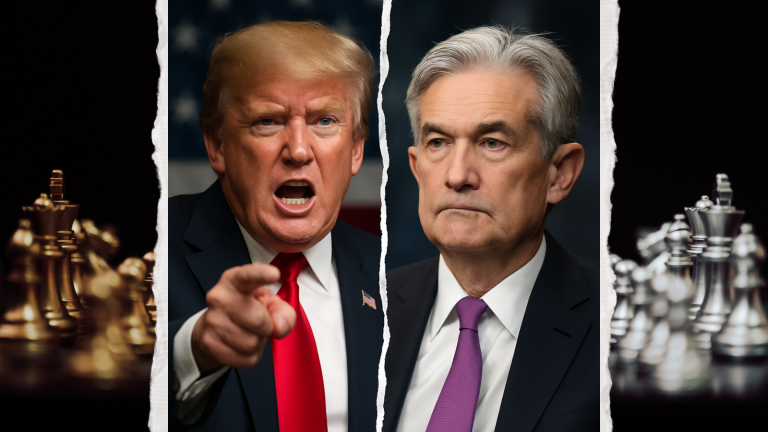Throughout American history, we’ve seen our fair share of rivalries.
Coke vs. Pepsi. Yankees vs. Red Sox. Celtics vs. Lakers. Microsoft vs. Apple.
Heck, you could even argue our country was built on feuds…
Aaron Burr and Alexander Hamilton’s fierce rivalry ended tragically on a New Jersey dueling ground, with Burr fatally shooting Hamilton.
Abraham Lincoln and Stephen Douglas clashed over slavery and the soul of America in debates that defined our nation’s future.
Viewed in this historical light, the ongoing spat between President Trump and Federal Reserve Chair Jerome Powell isn’t unprecedented, but it certainly commands attention.
Sure, the stakes aren’t pistols at dawn, nor do they possess the grandeur and decorum of those historic debates. Yet investors and markets hang on every social media post and off-hand remark, wondering how this tense feud over monetary policy will reshape the economy – and their own financial futures.
In today’s Market 360, I want to touch on the latest developments that happened between Trump and Powell this week. I’ll cover what’s behind the President’s criticisms and why I think he may have a point in this particular case. I’ll also share how you can position your portfolio for success no matter what happens with tariffs, interest rates or the market.
Trump’s War of Words
Beginning last Thursday, President Trump hasn’t been mincing words when it comes to the Fed – and specifically Jerome Powell. He took to Truth Social, his social media platform, and blasted the Fed Chair, suggesting that his “termination” couldn’t come soon enough.

The verbal jabs kept coming over the weekend, and markets opened on Monday on a sour note.
Trump’s criticisms didn’t sit well with the stock market, causing it to tumble sharply as investors worried Trump might fire Powell. All the major indices were down roughly 2.4% and 2.5% as a result.
But by Tuesday afternoon, Trump walked back his harsh words. He claimed he had “no intention of firing” Powell and argued the media exaggerated things. After Trump’s reassurance, stocks rebounded overnight, and by Wednesday, markets surged at the opening bell.
So, what changed Trump’s mind? Insiders say Treasury Secretary Scott Bessent and Commerce Secretary Howard Lutnick urged caution. According to reports, they reminded the president that the U.S. economy (and the stock market) has enough on its plate already – namely, in the form of tariffs.
Trump later clarified, “I would like to see [Powell] be a little more active in terms of his idea to lower interest rates. It’s a perfect time to lower rates. If he doesn’t, is it the end? No, it’s not, but it would be good timing.”
He also softened his tone on tariffs, hinting at easing his trade war by slashing China tariffs by as much as 65%, down from previous highs of 145%.
In the wake of these comments, stocks went on to rally for three straight days – with the S&P up over 6% this week.
What’s Behind the Feud
What’s obvious to me here is that Trump is becoming more sensitive to the market – and that’s a good thing, folks. But why all the back-and-forth?
After all, Trump originally hired Powell during his first term. And Powell’s second term doesn’t expire until May 2026.
It all comes down to two people with two different jobs, folks.
Trump wants to grow the economy. Lower rates will help do that. Powell, on the other hand, is concerned about managing inflation. So, he’s being cautious about lowering rates. In fact, Powell recently warned that the tariffs could cause lingering inflation, making rate cuts tricky.
Cutting rates might help short-term growth, but risks higher inflation down the road. And Powell made clear: The Fed won’t bow to political pressure.
However, in this case, I think Trump has a point. Powell may be acting a little too cautious here, especially since inflation has clearly cooled down lately. Waiting could slow down the economy more than necessary. In fact, the recent Beige Book survey from the Fed noted that economic activity remains roughly the same, although uncertainty over tariffs is high and there are some signs of increasing prices.
But what we need to remember is that a global interest rate collapse is unfolding. The European Central Bank (ECB) recently cut key interest rates by 0.25% for the seventh consecutive time. I remain in the camp that, due to recessions in France and Germany, the ECB will cut another three times this year.
That means it’s only a matter of time before our central bank will have to follow suit. So, I am sticking to my prediction that the Fed will be cutting key interest rates at least four times this year, hopefully starting at the May Federal Open Market Committee (FOMC) meeting.
According to CME’s FedWatch Tool, that probably won’t happen. It has an over 90% probability of no change. But by mid-June, that’s a different story – with a better than 60% chance of a quarter-point rate cut.

How to Survive the Market’s Waves
The bottom line is we all know markets love lower rates. Stocks often jump when the Fed loosens the reins on monetary policy.
I think we’ll get those rate cuts soon enough. But in the meantime, my advice remains simple: Focus on owning strong stocks backed by superior fundamentals.
These are the stocks that hold up the best when waves of uncertainty come crashing down on the market. And they’re usually the stocks that rebound first when the tide lowers and things are “all clear.”
And I hate to break it to you folks, but there is an even bigger financial tidal wave coming for investors. In fact, it’s the biggest I’ve seen in my over four decades in the market.
It has nothing to do with Fed policy, the White House, tariffs or anything like that.
And I’m making it my mission to prepare you for what’s coming.
That’s why I created this presentation. I’ll explain everything you need to know and the best way to not only survive – but thrive – in its wake.
Sincerely,

Louis Navellier
Editor, Market 360

